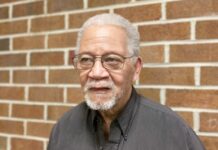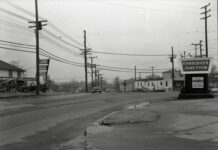 The Researcher
The Researcher
In the wealth of public health data that is collected in this country on everything from smoking habits to insurance participation, there is one area where there are very few statistics: Our attitudes on gun violence.
Sure, it is possible to track deaths or injuries from guns. But when it comes to how Americans feel about them, the data isn’t there, says Mark Dredze, a Johns Hopkins University computer scientist.
“For various political reasons, we don’t have those resources,” he says. “There is very little federal money for this research.”
Each year, the Centers for Disease Control and Prevention asks Americans about their health with a host of questions; while there used to be questions about guns on the survey, they are no longer included, Drezde says, adding that relevant to public health are questions about guns in the home, for example, and how they are secured.
Dredze specializes in artificial intelligence and his work centers on solving public health problems with non-traditional data. With the issue of gun violence, he has turned to an unlikely source to scientifically document public opinion: Social media.
What millions of Twitter users say about a topic “can be informative,” Dredze says, “beyond the pundits.”
Google searches can reveal a lot as well: In his data gathering in the days after the Oct. 1, 2017 mass shooting in Las Vegas, for example, Dredze learned some of the most common search terms were “gun control,” “terrorism” and later “bump stock” when it was revealed that the shooter used this device to effectively make his semi-automatic weapons fire automatically. In certain geographic regions, some terms were searched more frequently than others, which can illustrate how attitudes shift from region to region, Dredze says.
Collecting this data reveals how people process information on gun violence and what kind of messaging resonates with them. “Those are opportunities to inform people,” Dredze says. He cites Leonardo DiCaprio’s 2016 Oscar acceptance speech that included a call to action about climate change. Those words drove more Google searches on the topic than other messaging campaigns, he says.
Likewise, when Charlie Sheen announced in 2015 that he was HIV positive, searches about the virus increased along with the chance to provide public health information to patients who needed it. In a similar way, there could be opportunities to educate about gun violence, Dredze says.
“Whatever your position is on guns, presumably if we had data on (attitudes about) gun violence , it would be useful in decision making,” he says. “In this space, we are data starved.”
Dredze has completed projects at the IBM lab, Google’s research division and Microsoft and is a Twitter user himself, but admits to reading more than he posts (OK, the word he used is “lurker,” the proper tech slang for such behavior). He also was part of a group of researchers that tracked a spike in online searches about suicide and related terms in 2017, after Netflix released “13 Reasons Why,” a series about a teenager who kills herself.
As for the research on gun control, right now there are more questions than answers, he says. While there appears to be some evidence that Americans are supportive of gun control policies, there is still a lot of information to gather. “There’s so much that people care about,” he says. “And so much we don’t know.” —JESSICA GREGG

The Entrepreneur
Trevor Brooks is more than a denouncer of gun violence — he’s a former perpetrator, having been convicted of second-degree murder at 24. But after serving his time and attending an entrepreneurship program, Brooks knew he wanted to do something to, as he puts it, “stop the tears.”
Enter GunBail, a program he debuted in January of last year that exchanges voluntarily surrendered illegal firearms for bail. Here’s how it works: The family or friends of a person arrested for a non-violent crime and held on bail can submit a photo of a working, illegal firearm to the GunBail app, which will verify it and obtain the gun (whether through drop-off points, kiosks or other secure means). The person held on bail will then be released at no cost, save for a $99 processing fee — that is, if they belong to the eligible category of offenders decided upon by the court. The fewer guns on the streets, Brooks reasons, the fewer murders.
It’s not a get-out-of-jail free card for the arrested person; only those that turn the gun in are granted amnesty. But it is a way to give the person freedom until his or her trial, and offers a chance to enroll in GunBail’s aftercare programs — psychological or substance abuse treatment, housing assistance, workforce development training and more.
“I was very misguided, and that’s why I want to do this,” Brooks says. “GunBail is a way to reduce gun violence, reduce housing costs and address mass incarceration and socioeconomic problems by giving [those arrested] another chance. We (through another company) de-risk them and bond them to the very city they were arrested in.”
The program is not, he says, a gun buyback initiative — the likes of which cities across the country have used before with mixed results. Rather than offering relatively low compensation in exchange for amnesty, Brooks’ vision was to encourage the surrender of an illegal firearm when there are new incentives, like a new way to pay bail for those who can’t afford it.
“There are a lot of organizations that have been working against gun violence, but they’re more symbolic than effective,” he says. “There are 357 million guns and less than 75 million of them are registered. That means there are hundreds of millions of guns around the country that we don’t know where they are. Some of these guns have been killing over and over again for decades. Even if all gun legislation was passed, urban communities wouldn’t see a change for 30 years at least.”
He argues, too, that the free program will save cities money, reducing the costs of housing inmates and, with the help of the aftercare programs, turning its citizens into more productive individuals who will not require as much city-funded intervention.
There’s one critical flaw in Brooks’ carefully designed plan, however: It requires full participation and authorization from the city — and Baltimore’s not all-in. Though Brooks has met with several influential city officials, including Mayor Catherine Pugh, and has communicated with city councilman Brandon Scott (who went so far as to introduce a resolution supporting GunBail’s implementation), the program has not moved forward. And though he has since moved on to pitch the program to other cities with more success, the lack of support from his home city is certainly a sore spot.
“I wanted to be in Baltimore,” he says. “That’s where I lost so many people [to gun violence]. I thought we could make the maximum difference there. Things are not getting better. We have solutions. But they’re all just saying ‘we’re so tired of this [violence], but we’re not even going to try to fix it for political reasons.’” —KIMBERLY USLIN
 The Activist
The Activist
Erricka Bridgeford has lived in Baltimore all of her life. She’s been surrounded by
violence since childhood, losing her brother, stepson and many friends to guns in her beloved city.
“Now that I’m 45, it’s devastating to really understand what was happening in my world,” she says, “and it has not stopped.”
As director of training at Community Mediation Maryland, Bridgeford’s day job is to help facilitate neutral environments where individuals or groups of people in conflict can come together in a nonjudgmental and confidential space to work toward a resolution. She also organizes police-youth dialogues, where teenagers and city police officers have the opportunity to spend time together and learn about each other.
“When people feel understood, they can decide for themselves what justice looks like and what will resolve the conflict for them,” she says.
Naturally, when Baltimore hip hop artist Kevin “Ogun” Beasley came to Bridgeford in 2017 with the idea of a citywide ceasefire — the same kind of safe space she seeks to create at work — she immediately felt drawn to the cause. “I was ignited in my spirit, and we had to at least try,” she says.
Last August, Baltimore Ceasefire 365 held its first weekend of peace, organized by Bridgeford and a group of fellow activists. Its purpose was twofold: For Baltimore residents to make a commitment to be nonviolent; and for the city to gather in
celebration of life. Community organizations hosted more than 50 events in support of the cause.
Bridgeford remembers looking at her Facebook page that weekend and the days leading up to it, struck with awe at the number of people who changed their profile pictures to the Baltimore Ceasefire flyer.
“That weekend, we went 41 hours without murder,” Bridgeford says. “There was a five-hour period where two people were killed, so out of 72 hours, we got 67 hours of peace.”
Bridgeford set up a Paypal account to raise funds for the families of the weekend’s two murder victims and donations came in from across the city, as well as from countries like Norway, Australia and China.
“We called the ceasefire and the world came for the story,” she says.
The next ceasefire was held in early November. One man, an off-duty Washington, D.C. police officer, was killed in West Baltimore. Within hours, ceasefire volunteers went to the Braddish Avenue neighborhood where he died to “pour love into the space,” Bridgeford says, and to burn sage for spiritual cleansing.
Across town, The National Great Blacks in Wax Museum shifted the focus to Baltimore’s future with the creation of a 365 Legacy Time Capsule that included scriptures as well as statements from residents about their “commitment to peace in Baltimore City,” Bridgeford adds.
Overall, Baltimore was free of murder for a total of 71 hours.
“There has been a lot of focus on what’s wrong and it’s impacting Baltimore’s self esteem,” Bridgeford adds. She hopes to change that in a proactive way. “Baltimore has forgotten its light, and I want us to look at how beautiful we are as a city.”
Moving forward, Baltimore Ceasefire 365 plans to hold a ceasefire weekend four times a year. It’s the right path to progress, says Bridgeford, who feels that she has had only two choices since her brother’s death. “You can let it take you under, or you can be an alchemist with the pain and transform it into change.” —LIZ MCMAHON




I am a Community Mediator in the Bronx and I am astonished at the participation level and extraordinary success of the Baltimore Community in the Ceasefire Project. You are all to be lauded for raising the city up.
I hope to pass this word around NYC and don’t be surprised if you hear from us.
Peace and Life.